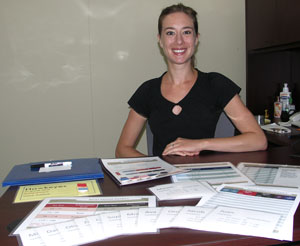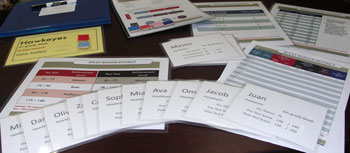Activity Aids Teaching of Value Added
AUGUST 2013
 Photo: Anne Marie Weber, a professional development specialist, helped develop an activity aid to explain how value added works. It is now being used in VARC's professional development seminars across the U.S.
Photo: Anne Marie Weber, a professional development specialist, helped develop an activity aid to explain how value added works. It is now being used in VARC's professional development seminars across the U.S.
A new activity created by VARC is helping educators around the country gain a better understanding of what value added is and how it works.
Developed in early 2013, the hands-on activity was recently incorporated into VARC’s professional development workshops for educators in two states to glowing reviews. Educators said the activity helped them understand the methods behind the creation of the data they use to improve instruction at their schools and in their districts.
“A central aim of our professional development is to give educators a clear picture of how value added works. Once educators understand the process of how value-added calculations are made, it’s easier for them to see how their schools’ and districts’ value-added data can be useful to them,” said Anne Marie Weber, a professional development specialist with VARC.
In the activity, participants are presented with simplified academic information on fictional students in made-up schools and then given instructions on how to calculate achievement and value-added scores. The activity’s game-like presentation and features are designed to be fun for participants, which helps encourage engagement in what might otherwise be perceived as a daunting, math-heavy topic, according to Weber.
“We talk so much about the math, it’s really helpful to see a simplified version of how we actually calculate gain, proficiency, and a school’s value added, and the fact that we’ve made it a little more fun than reality helps keep people interested in the material,” Weber said.
 In the activity, participants form teams and are given mock data points, including pre- and post-test subject scores and ELL status, on 30 students in the same class. Then, they use a predicted test-score table and an achievement level guidepost chart - both created by VARC specifically for the activity - to calculate student achievement and value-added figures in their fictional schools.
In the activity, participants form teams and are given mock data points, including pre- and post-test subject scores and ELL status, on 30 students in the same class. Then, they use a predicted test-score table and an achievement level guidepost chart - both created by VARC specifically for the activity - to calculate student achievement and value-added figures in their fictional schools.
“When we start with fake data, as opposed to data from the participants’ own schools, it’s easier for participants to get a clear picture of how we calculate value added and how it can be informative and useful to them,” Weber said.
The activity takes between 45 and 60 minutes, and usually takes place after presentation of VARC’s Oak Tree Analogy, which is the first measure used to explain value added in VARC’s professional development training sessions. After the hands-on activity, educators are then given actual value-added data from their districts to review and analyze.
In anonymous feedback surveys completed following several professional development sessions, educators described the activity as “most helpful” and “outstanding.” In coming months, VARC has plans to expand the roll-out of the activity to all of the states in which it hosts professional development workshops. It will also be incorporated into VARC’s 2014 Wisconsin State Meeting.
